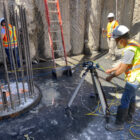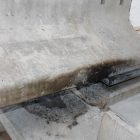Parking garages require routine inspection and maintenance to ensure they remain safe and operational. Whether it is public parking in extremely busy downtown area or a private condominium structure, proper maintenance is needed to keep them safe. The importance of parking garages is often ignored, simply because nobody lives in them. While these facilities are often exposed to harsh conditions, they are under-maintained and over-used (John M. Porter, PE, and Nathan D. Boutin, PE).
Structural Deficiencies in Parking Structures
Several deterioration mechanisms can affect the structural and durability performance of key components in parking structures. Even when they are indoors, moving vehicles may help expose garage floors to aggressive agents. In general, parking garages in Canada (and other cold regions ) are exposed to de-icing salts (or other chemical). This can expedite the rate of steel corrosion; freeze and thaw cycles, and moisture (Read more). The cyclic loading resulting from the movement of vehicles can also aggravate the condition of concrete slabs. This deterioration mechanism can affect the safety and reliability of the structure. Porter and Cohen believe that “it is critical to identify the cause of the damage to identify repair alternatives and estimate repair costs” (Porter and Cohen).
Structural deficiencies in parking structures can compromise the safety, stability, and integrity of the entire facility. Here are some common structural deficiencies observed in parking structures:
- Inadequate Waterproofing: Parking structures are exposed to rain, snow, and moisture. Without proper waterproofing measures, water can penetrate the structure, leading to deterioration, corrosion, and weakening of the concrete and steel reinforcement.
- Concrete Degradation: Concrete is commonly used in parking structure construction, and over time, it can degrade due to factors like exposure to harsh weather conditions, chloride ingress, carbonation, and alkali-aggregate reactions. This degradation can lead to cracking, spalling, and reduced load-bearing capacity.
- Corrosion of Reinforcing Steel: If the reinforcing steel within the concrete is not adequately protected, it can be exposed to moisture and chloride ions, leading to corrosion. Corroded steel expands, causing cracking and spalling of the concrete, and compromises the structural integrity of the parking structure.
- Insufficient Load Capacity: Parking structures need to support the weight of numerous vehicles simultaneously. Inadequate design or construction practices can result in insufficient load capacity, leading to excessive deflection, structural deformation, or even collapse.
- Inadequate Expansion Joints: Expansion joints accommodate thermal expansion and contraction of the structure. If expansion joints are insufficient in number, size, or functionality, it can lead to stress concentrations, cracking, and structural failure.
- Lack of Redundancy: Structural redundancy refers to having multiple load paths and redundant elements that can carry the load if one element fails. Insufficient redundancy in the design of parking structures increases the risk of localized failures and compromises the overall safety of the structure.
- Improper Maintenance: Neglecting regular inspections and necessary maintenance can exacerbate existing structural deficiencies, allowing them to worsen over time. Without timely repairs and preventive maintenance, the structural integrity of the parking structure can be compromised.
Maintenance of Parking Garages
Every parking garage structure needs a comprehensive maintenance plan. This is necessary to protect the owner’s investment, regardless of age and type of construction. Most life-cycle problems can be prevented or reasonably managed through proper design, construction and maintenance (Porter and Cohen). Porter and Boutin believe that when parking structures are not maintained properly, (i.e. inspection and building condition assessments are not performed on a regular basis), the cost of repair costs can grow exponentially. In order to maintain the parking structures in good condition, routine visual inspection is strongly recommended. Furthermore, structural condition assessment when the early signs of defects are observed can help reduce the repair cost down the road. The following provides a general overview of steps required to keep your parking structure safe.
1- Preliminary Assessment: Visual Inspection
A well-planned visual inspection of structural and non-structural components can help property managers with identifying the maintenance needs. A comprehensive visual inspection can help assess the ongoing deficiencies, and help the managers with effective repair and rehabilitation plans. Digital Visual Inspection with the help of LiDAR technology, photogrammetry, and 360 cameras can be used for more time and cost-effective inspection. By properly recording the ongoing issues, engineers will be able to assess the overall integrity of the asset and request proper testing (intrusive or non-destructive) to be performed. Acoustic sound test (chain dragging or hammer sounding) can be used to assess the location and extent of delamination and/or scaling.

2- Structural Condition Assessment
Structural condition assessment may be needed when the visual inspection show evidence of structural deficiencies . Such deficiencies can manifest themselves as:
- Excessive cracking in beams and slabs
- Corrosion, and delamination of concrete (usually sign of rust is observed)
- Spalled concrete
- Water Leaking into the building envelope
Depending on the nature and extent of deficiencies, the structural condition assessment may involve a series of Intrusive and non-intrusive testing to assess the strength, and durability of concrete materials. In the next section, we will focus on the Non-destructive Testing methods that can be implemented in the structural condition assessment of parking structures.
Non-Destructive Testing for Parking Structures
Non-destructive testing can be beneficial when dealing with large areas in parking structures. NDT methods can help property managers and their consultant to develop a precise map of deficiencies, their location, and severity.
1- Half-Cell Corrosion Potential Mapping: When the structural components (slabs, walls, beams, and columns) show evidence of corrosion, the owner should take proper steps to assess the corrosion activity. Half-Cell Corrosion Potential Mapping is a widely used test procedure to identify the areas with higher probability of active corrosion. The test can be used to locate active corrosion in precast double T beams, concrete slabs, and perimeter walls. It can also be used to assess the condition of concrete girders and columns.
2- Surface Electrical Resistivity: Electrical Resistivity of concrete can provide useful information about the resistance of concrete material to penetration of chloride ion. This method is adapted by several Department of Transportation (DOTs) to replace the labour-intensive and time-consuming Rapid Chloride Permeability Test (RCPT).
3- Ultrasonic Testing (Ultrasonic Pulse Velocity / Ultrasonic Pule Echo): Acoustic methods can be used to locate and quantify delaminated area on the concrete slab. Acoustic method have successfully been used for evaluation of concrete deck slab in bridge structures. They can be used to detect voids in walls, or slabs, as well as predicting the thickness.
4- Ground Penetrating Radar – GPR: GPR is a powerful method in evaluating the condition of existing parking structures. The GPR maps can be used to identify the structural details of concrete elements such as walls, beams, and slabs. This is specially important in the rehabilitation of existing parking structures where structural drawings are not available. Another application of GPR in parking garages is for rapid screening of the slabs for corrosion. The GPR scans can help structural engineers narrow down the areas that requires further inspection and testing.





